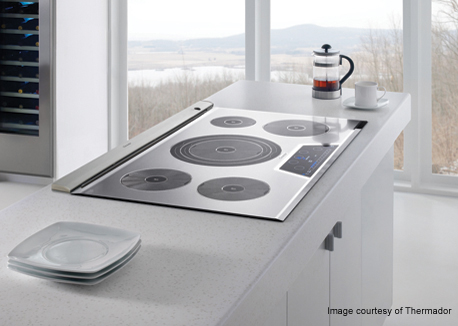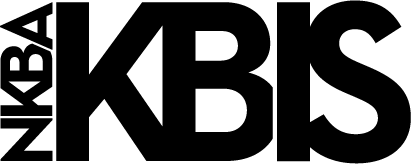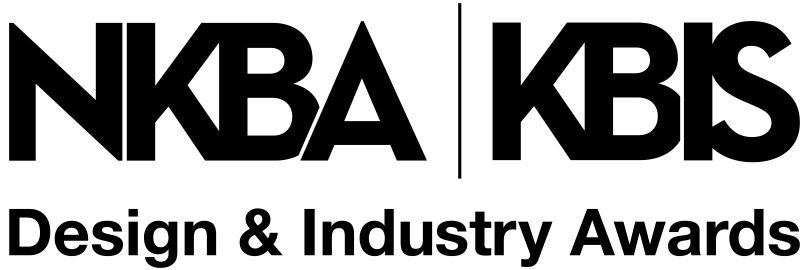Although it was first introduced in the U.S. in the 1980s, mystery
continues to enshroud the induction cooktop. How exactly does it work?
What are its benefits? And what types of cookware can be used? For
answers to these questions and more, K+BB spoke to Malte Peters, cooking product manager at BSH Home Appliances, who knows just a thing or two about induction technology.
HOW IT WORKS
As
opposed to traditional gas or electric cooking for which heat is
generated by a flame or electric element, respectively, and transferred
to the cookware, induction cooking “uses a power coil to produce a
high-frequency electromagnetic field,” explained Peters. This field
then penetrates the induction-compatible cookware (more on this below)
and “sets up a circulating electric current that generates the heat,
which in turn is transferred to the cookware’s contents.” In a
nutshell, electromagnetic technology allows the cookware itself to
become the generator of cooking heat.
Because the cookware
transfers heat directly to its contents—and because there is no open
flame or radiant heat to dissipate—the cooktop remains cool to the
touch. “Nothing outside the cookware is affected by the electromagnetic
field,” explained Peters. “As soon as the cookware is removed from the
elements, or the element is turned off, heat generation stops.” This
brings us to the many benefits of induction cooking.
BENEFITS
In
addition to a cool cooking surface with no open flame or exposed
heating element (great for households with children), induction
technology:
• provides rapid heating
• conserves
energy—according to the Department of Energy, the efficiency of energy
transfer for an induction cooktop is 90 percent, versus 71 percent for
a smooth-top non-induction electrical unit. This equals an approximate
20 percent savings in energy for the same amount of heat transfer.
Also, the cooktop will not heat up the kitchen, resulting in added
energy efficiency.
• is easy to clean. Induction cooktop
surfaces are flat and smooth. In addition, the surface will not get
hot, so spills will not stick.
• has similar controllability to a gas cooktop, so the element does not require time to cool down or heat up.
•
is more precise and more responsive than other cooking methods. Because
induction cooking heats only the contents of the pan, noted Peters, “an
induction cooktop can be adjusted to quickly go from a low simmer to a
heavy boil in faster times than gas or electric cooking.”
COMPATIBLE COOKWARE
While
these benefits could mean a more convenient and conserving kitchen,
they won’t matter much if you’re not using the correct cookware. As
Peters explained, “Induction cooktops are compatible with cookware made
of magnetic (or ferrous) materials, such as stainless steel and cast
iron.” Non-ferrous materials, such as glass, ceramic, copper and
aluminum, will not conduct. Also, make sure the bottom of the cookware
is flat. The more surface area touching the element, the more efficient
the cookware (and cooktop!) will be.
For those who think they
may have induction-compatible cookware already in their kitchens,
there’s a very easy test: If a magnet sticks to the cookware, then it
will work on an induction cooktop. If it doesn’t stick, it won’t.
Some
homeowners may choose to use an induction disc (a ferrous disc placed
between the induction element and a incompatible pot or pan—induction
will heat up the disc and transfer the heat to the pan) in order to
continue using their existing, incompatible cookware on their new
induction cooktops. However, be aware that it may “prevent the cooktop
from transmitting enough energy and ultimately can limit the cooktop’s
performance,” cautioned Peters.
When shopping for
induction-compatible cookware, look for notification on the product
itself. “A lot of cookware is now sold with a label or logo saying
‘induction ready,’” said Peters. Short of shopping with a magnet in
your pocket, simply look and see what the prospective pot or pan is
made from.
Whether induction catches on in America this year or
10 years from now, it’s a technology with great benefits. As Peters
said, “Induction cooking delivers precision, efficiency, safety and
technology, as well as the cooking performance of gas combined with the
cleanability of electric.” What’s not to love?
Searching for cookware options? Look no further! We’ve rounded up some cookware that’s sure to work on any induction cooktop.









